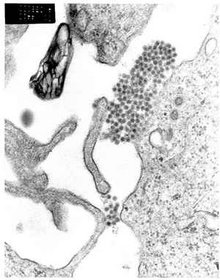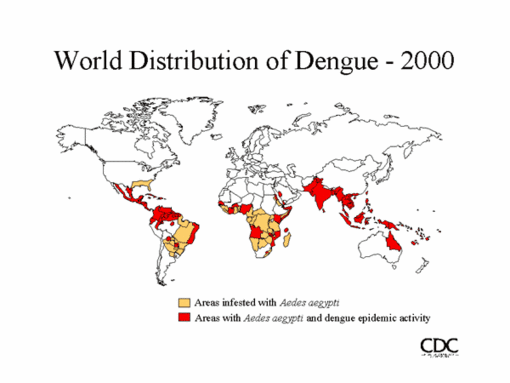Dengue fever
Dengue and dengue hemorrhagic fever (DHF) are acute febrile diseases, found in the tropics, with a geographical spread similar to malaria. Caused by one of four closely related virus serotypes of the genus Flavivirus, family Flaviviridae, each serotype is sufficiently different that there is no cross-protection and epidemics caused by multiple serotypes (hyperendemicity) can occur. Dengue is transmitted to humans by the mosquito Aedes aegypti (rarely Aedes albopictus). more...
Signs and symptoms
The disease is manifested by a sudden onset of fever, with severe headache, joint and muscular pains (myalgias and arthralgias — severe pain gives it the name break-bone fever) and rashes; the dengue rash is characteristically bright red petechia and usually appears first on the lower limbs and the chest - in some patients, it spreads to cover most of the body. There may also be gastritis with some combination of associated abdominal pain, nausea, vomiting or diarrhoea.
Some cases develop much milder symptoms, which can, when no rash is present, be misdiagnosed as a flu or other viral infection. Thus, travelers from tropical areas may inadvertently pass on dengue in their home countries, having not being properly diagnosed at the height of their illness. Patients with dengue can only pass on the infection through mosquitoes or blood products while they are still febrile.
The classic dengue fever lasts about six to seven days, with a smaller peak of fever at the trailing end of the fever (the so-called "biphasic pattern"). Clinically, the platelet count will drop until the patient's temperature is normal.
Cases of DHF also shows higher fever, haemorrhagic phenomena, thrombocytopenia and haemoconcentration. A small proportion of cases leads to dengue shock syndrome (DSS) which has a high mortality rate.
Diagnosis
The diagnosis of dengue is usually made clinically. The classic picture is high fever with no localising source of infection, a petechial rash with thrombocytopenia and relative leukopenia.
Serology and PCR (polymerase chain reaction) studies are available to confirm the diagnosis of dengue if clinically indicated.
Treatment
The mainstay of treatment is supportive therapy. The patient is encouraged to keep up oral intake, especially of oral fluids. If the patient is unable to maintain oral intake, supplementation with intravenous fluids may be necessary to prevent dehydration and significant hemoconcentration. A platelet transfusion is indicated if the platelet level drops significantly.
Epidemiology
The first epidemics occurred almost simultaneously, in Asia, Africa, and North America in the 1780s. The disease was identified and named in 1779. A global pandemic began in Southeast Asia in the 1950s and by 1975 DHF had become a leading cause of death among children in many countries in that region. Epidemic dengue has become more common since the 1980s - by the late 1990s, dengue was the most important mosquito-borne viral disease affecting humans after malaria, there being around 40 million cases of dengue fever and several hundred thousand cases of dengue hemorrhagic fever each year. In February 2002 there was a serious outbreak in Rio De Janeiro, affecting around one million people but only killing sixteen.
Read more at Wikipedia.org




